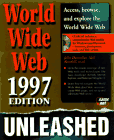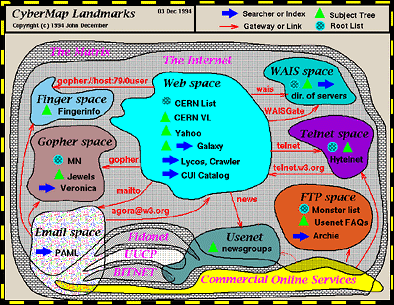 |
|
|
||||||||||||||||||||||||||||||||||||||||
|
Conceptual Map of Net Spaces - Circa'94 It is important to realise that the Internet is not just the Web. Many people are unaware that the Internet in fact provides a rich array of services beyond those beginning with WWW. I'm a geographer so I like to think of these as different information spaces, with differing virtual 'geographies'. A good way to get a sense of the different information spaces of the Internet, their shape, size, landmarks and interconnections, is to map them. One of my favourite conceptual maps of net spaces was drawn back in 1994 by John December [1].
December's Cybermap Landmarks reveals the geographies of net spaces, providing a good way of conceptualising them as distinct and self-contained domains, but with fluid, irregular boundaries and many interconnections and overlaps between them. The map also shows us the networks beyond the Internet, such as FidoNet and BITNET, that make up the larger, globe-spanning Matrix of computer-communications systems. John December is a successful Internet consultant running his own firm, December Communications Inc., based in Milwaukee, Wisconsin. He has written and presented extensively about the Internet, the Web and broader issues of computer-mediated communications, and he is perhaps best known for his books such as The World Wide Web Unleashed [2]. He created a number of different conceptual cybermaps in the mid 1990s to try and give a 'big picture' overview of the nature of cyberspace [3]. However, he freely admits to the limits of his cartographic ambitions and commented to me recently, via e-mail, that: "In a way, my 1994 map was very naive - I didn't really have a clear idea of global nets at the time, but I intuitively pictured the conceptual relationships much like ancient tribes did - I knew that there was "this place" and "another place" and ways to "get" from one place to the other." Despite the naiveté of the map, I think it still provides one of best conceptual views of cyberspace and today it has added historical interest because it was drawn five years ago. The map is easy to comprehend and is particularly suited as an educational tool to introduce the nature of the net to new users. The map also has added personal resonance for me because it represents the net as it was in the mid 1990s when I first began exploring it. Although I'd been using a bit of e-mail since I went to university in '89, it was not until the end of 1993, when I became a researcher with the freedom to really explore the net, that I realised that there was such a complex and fascinating 'world in the wires'. The net as represented on December's map is very much the net of my first memories. I can remember 'burrowing' through Gopher's seemingly endless text hierarchies and searching for interesting downloads in ftp space with Archie. This was a time before I had heard about Mosaic and the Web, with the net being very much a place composed of text and accessed through a command-line interface.
December's map is hand drawn and has a fun and friendly sketch quality. The networks and information spaces are drawn as puddle-like blobs. There are several distinct networks, labelled in purple, showing the diversity of cyberspace in 1994. The Matrix is the largest blob and is the container for almost everything. It contains the Internet (and its information spaces running over TCP/IP) as the largest network, along with notable, but much smaller, networks of FidoNet, UUCP, and BITNET [4]. There was also a sizeable presence of commercial online services in the early 1990s (such as AOL, CompuServe, Prodigy, and GEnie) which were generally closed and proprietary in nature, and not part of the Internet. The heart of the map focuses on the eight most significant information spaces in the mid 1990s identified by December. These were the Web, gopher, e-mail, finger, WAIS, telnet, ftp and Usenet, and they are represented by different coloured blobs. Most of these information spaces are contained within the Internet, except for e-mail and Usenet which spill over to other networks. The key landmarks for each information space are clearly labelled and the connections between spaces are represented by red arrows. So for e-mail space in 1994 one of its landmarks was the Publicly Accessible Mailing Lists (PAML) [5] index, while the Web's landmarks were the, then, new search engines and directories like Lycos, Web Crawler, Yahoo! and CERN's venerable Virtual Library [6]. Connections between Web and e-mail information spaces were possible in both directions as indicated by the red arrows. From Web space the mailto html tag makes a connection into e-mail space. The reverse connection could be made using Agora servers which enable users to request Web pages via e-mail [7]. There were a wide range of interconnections between all the information spaces, but most especially with the Web. What makes these information spaces different from one another are the modes of information exchange, degrees of synchronicity and levels of social interaction they support. At a fundamental level, the differences between information spaces are caused by the different protocols used by software applications to communicate over the Internet, which give rise to the different form and functions apparent to the end-user. This kind of protocol separation is intuitively apparent from December's map.
The map was drawn at the end of 1994 and the nature of the Internet has changed markedly since then, with certain information spaces dying off as they fall out of favour with users, particularly WAIS and Gopher. Undoubtedly, the biggest change has been the inexorable and exponential growth of Web space which would now be a huge blue blob on the map, squeezing and submerging many other information spaces. For many end-users the Web, seen through the browser interface, is the only information space, although e-mail is still the most widely used. But even here, the Web is coming to dominate with the growing popularity of Web-based e-mail services like Hotmail. Other important information spaces within the global Internet have evolved and grown to prominence since December drew his map. Notable examples include, instant messaging (e.g. ICQ), chat environments (e.g. IRC), multi-user game spaces (e.g. Quake) and streaming media (e.g. RealNetworks, MP3s). Also, large intranets have proliferated, creating important private information spaces, which are largely unseen from the outside and are therefore difficult to quantify and map. While at the scale of the networks of the Matrix, John December commented to me, via e-mail, that since 1994 there has been "the swallowing up of all alternate networks into the Internet…everyone thinks of only the Internet as the online world." Looking at Web space in a bit more detail, many of the landmarks identified by December at the end of 1994 are still with us at the beginning of 2000. This is perhaps surprising given the rapid pace of change on the Internet, although some of them are much less visible today, particularly CERN. This was the home of the Web in the early 1990s and was one of its pre-eminent landmarks, but today it has gone back to just being a leading particle physics research centre. The most notable enduring successes are Yahoo! and Lycos which are still prominent landmarks today [8]. If the map were to be redrawn there are many new sites that have become modern day landmarks of the Web, for example the mega portals such as MSN, AOL and Excite@Home which are battling for dominance. It is interesting to note that AOL, which is so dominant today, was a proprietary online service largely disconnected from the Internet when December's map was drawn. The towering presence of Microsoft/MSN on the Internet today was not evident at all in 1994 [9]. There has also been the e-commerce explosion with the rise of high-profile sites exemplified by eBay and Amazon.com. Despite the tremendous growth of the Internet over the last five years, in many ways the diversity of user experience of different information spaces has been shrinking. But there is a fascinating world of net exploration if one looks beyond (or maybe it's below?) the Web browser window. It would be fascinating to see a conceptual map of net spaces for 2000 and John December says that he "… hopes to draw a new cybermap for the present age in the same spirit as my 1994 map, but that project will wait for a few more things I need to get done." We wait to see what his new map will reveal about net spaces. Copyright © 1999, 2000 media.org. ISSN: 1530-3314 |
|||||||||||||||||||||||||||||||||||||||||
|



